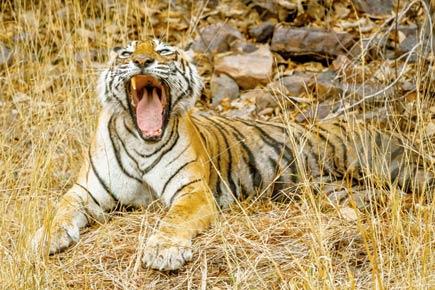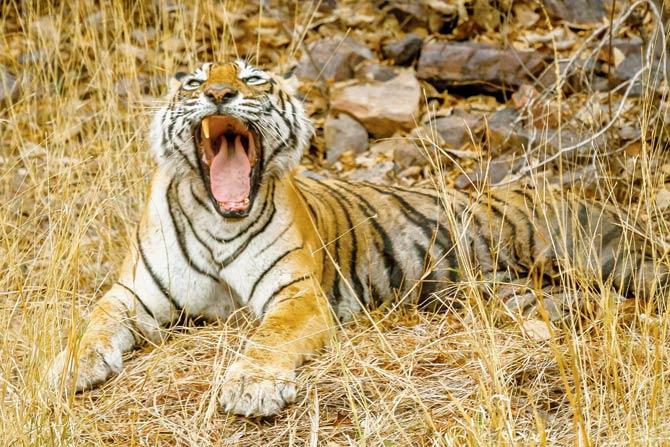The legendary tigress of Ranthambore, Machali, passed away on August 18. Here's all you must know about her

1997: Machli was born in the month of July-September 1997 at Ranthambore Nataional Park in Rajasthan. She is said to be among the three litters that were born to a tigress, Original Machli. She was named Machli because her mother had a fish-shaped mark on her right cheek. I had first seen her near Takia ki Kui in Ranthambhore when she was around 7-8 months old.
ADVERTISEMENT

Pic/Pranad Patil
“Her mother had killed a sambar near this waterhole and the family of four spent a few days over there, to my wife’s and my delight. Between 2000 and 2011, I have either worked or been closely associated with film documentary projects on Machli,” states Singh in a blog on his website.
1999: By 1999, the tigress had matured enough and taken over the portion of her mother’s territory.
2002: The tigress was identified as Machli in the BBC documentary that was broadcast in the year 2000. The same year, she mated with the then largest male in the park, “Bamburam” and had her first litter of two male cubs in the early monsoons. These two cubs were called “Broken Tail” (because the end of his tail was broken) and “Slant Ear” (for no apparent reason though Billu Chauhan always though his ear was slanted). Machli mated with another male “Nick Ear” in early 2002 and had a second litter by April 2002. “First saw three cubs on June 30, 2002, on the last safaris in the park for that season. One cub probably died in the monsoons, as only two were seen when the park reopened in October 2002. These two — one male and one female — were called ‘Jhumroo’ (male who is now the biggest male in Ranthambhore National Park and is numbered T20) and ‘Jhumree’ (a female who disappeared in 2004, when India was going through a massive spate of tiger poaching), so named by GS Bhardwaj, who was the Deputy Field Director then. These two stayed with Machli in the lakes till the end of 2004, when Machli mated again with ‘X male’ (later numbered T2). Soon after, Jhumree was pushed out by Machli (and never seen again), while Jhumroo stayed on for a few months longer and then moved to Lahpur valley-Jed Kho area in the park, where he has stayed since,” states Singh in his blog.
March 2005: Machli had a third litter of two cubs, a male called “Bahadur” (later numbered T3) and a female called “Sharmelee” (later numbered T1). By this time Machli had lost three of her canines and was not expected her to have any more litters, but she surprised everyone. They stayed with Machli till the monsoons of 2006, when Machli had her fourth litter. Soon after she had her fourth litter, she turned aggressive towards Sharmelee and pushed her to the Lakkarda Valley, while tolerating Bahadur, who was seen with the small cubs of Machli’s fourth litter till some months later. Soon, Bahadur established himself in the Bandarwal Baori-Thumka area of the park, where she still lords. Sharmelee was later relocated to Sariska where she is now known as ST2.
2006: By the beginning of summers of 2006, Machli started mating again with “X male” and by late monsoons she had a fifth litter of 3 females cubs. These three cubs were numbered T17, T18 and T19. All three of these cubs are now dominant females of their area. While T18 was relocated to Sariska (renumbered from T18 to ST3), T17 (“Sundari” who died of injuries sustained in two different fights with two different males) and T19 (or “Krishna”) had carved out their own territories in the park. They each had one litter of three cubs each before TT17 died. Both these litter are fully grown up and T19 has had another litter of three cubs who too are nearly fully grown up right now.
2016: According to forest department officials, on August 18, 2016 at around 9.50-55 am, Machli died of old age on the fringes of the Ranthambore National Park.
Aditya Dicky Singh is an ace wildlife photographer and Wildlife Conservationist based in Ranthambore.
 Subscribe today by clicking the link and stay updated with the latest news!" Click here!
Subscribe today by clicking the link and stay updated with the latest news!" Click here!






